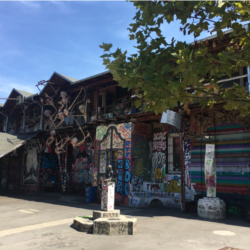
Ljubljana doesn’t feel anything like the rest of its fellow former-Yugoslav capital cities. It seemed to have more in common with Salzburg or Vienna than Sarajevo or Skopje, including the highest prices I came across in the region.
Perhaps a little modern Slovenian history can help explain this: After Yugoslav President Josip Broz Tito’s death in 1980, Yugoslavia went into an economic depression and a period of massive political instability. While the Serbs mostly wanted to keep the socialist republics that made up Yugoslavia together, the other groups began to embark on measures to declare themselves as independent states. In 1990 Slovenia held its first democratic elections; full independence was declared in 1991, which sparked a brief military conflict with the Yugoslav People’s Army called the Ten-Day War from June 27-July 7, 1991. Not to minimize any loss, but compared to the bloodshed experienced in present-day Croatia, Bosnia and Herzegovina, Serbia, Montenegro and Kosovo, Slovenia was able to establish itself as a nation with limited casualties; Macedonia was the only former-Yugoslav republic to break away without a single loss of life.
After declaring independence, change appears to have occurred rapidly in Slovenia, and in particular Ljubljana. Slovenia joined the EU in 2004 and Ljubljana was named “European Green Capital” in 2016.
All of this history (and more!) is expertly and interestingly displayed at the Mestni muzej Ljubljana (City Museum of Ljubljana), where I began my leisurely day in the city. The special exhibit “Nova Doba Prihaj!” (A New Age is Coming!) was excellent and gave a fascinating look into how commerce developed in the city through the industrial revolution, followed by state-owned entities in communist times and finally how it businesses reverted back to being privately owned in the 1990s.

After the City Museum, I continued on my history kick to Trg republike (Republic Square). Many Slovenians gathered here to protest and it was in this square that independence was declared in 1991.

On one side of the square are several war monuments that Tito commissioned to commemorate events in WWII. He had similar monuments erected throughout Yugoslavia and many have been removed since, but this Spomenik revolucije (Monument to the Revolution) designed by Drago Tršar and completed in 1975 still remains.

Another side of the square you can see the Zgradba Državnega zbora (National Assembly Building), which is free and open to the public, but you need to set up a guided tour beforehand. Unfortunately I didn’t realize this and missed out on seeing the interior, but if you have interest it seems an easy enough process to do so.

Around the corner to the left is Predsedniška palača (Presidential Palace) and to the right is the Narodni muzej Slovenije (National Museum of Slovenia). I wasn’t nearly as taken with the National Museum as I was with the City Museum, and between the two I definitely recommend the latter.

Directly in front of the entrance to Tivoli Park, Ljublana’s largest green space, is the Moderna galerija Ljubljana (Museum of Modern Art), which more than made up for my disappointment with the National Museum. When I bought my ticket I was handed a packet of explanations about the different styles of Slovenian art on display; the descriptions were a bit wordy, but they really did help me better appreciate the pieces.
The special exhibition “The Heritage of 1989” was one of the coolest I’ve seen. The curators reassembled almost all of the pieces from the last major art exhibition in Yugoslavia, which took place in Sarajevo. They were clear though: this was not merely a “reconstruction” of the event. According to the packet, the works at the time were created and exhibited “without any direct reference to current social issues,” and through this current exhibit the pieces were being presented in the context of the socio-political climate at the time. This was the perfect way to bring everything I was learning all morning about the history and politics of Yugoslavia and Slovenia together in a raging symphony.
After all that, I earned my picnic lunch in Tivoli Park!!

After a stroll in the park I made my way to Prešernov trg (Prešeren Square) in the center of the capital. The square is named after the poet France Prešeren, whose monument acts as an easy meeting point.

The salmon pink exterior of the Frančiškanska cerkev Marijinega oznanjenja (Franciscan Church of the Annunciation) is also on the square, and may be the most recognizable sight in Ljubljana. I saw some pretty impressive street performers in the square and for fans of people watching, this is the place to be.

The real beauty of Ljubljana can be found along the banks of the Ljubljanica River that passes by Prešernov trg. Let me take you on a little journey down the river:


Lastly, I would be remiss to not mention the dragons you will see all over the city, the famous of which are on the Zmajski most (Dragon Bridge). The dragon is the symbol of Ljubljana; legend has it that Jason, from Greek mythology and Argonaut fame, came upon the city and slew the dragon that terrorized those living along the river.

After all this walking around, it was time for some sustenance and luckily right across the river you can find the Odprta kuhna (Open Kitchen), an eclectic local food bazaar. I found some tasty Indian food and tried some liquid nitrogen based mango ice cream for dessert.

This is exactly how I like to spend a day: a little history, a splash of art, some nature and lots of tasty food!
